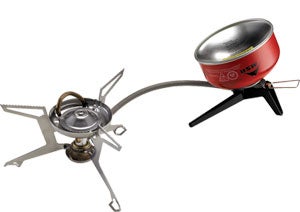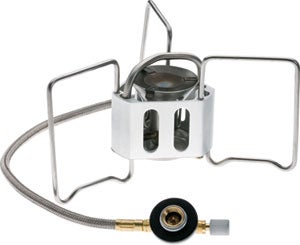Heading out the door? Read this article on the new Outside+ app available now on iOS devices for members! Download the app.

Stove: MSR Whisperlight Universal ($140; 11.5 oz.; msrgear.com)Fuels accepted:Canister, white gas, keroseneBoil times (first bubble/rolling boil): 1:25/5:18
Performance and ease of use: Excelled with all types of fuels, including canisters. Had superb liquid-fuel performance in single-digit weather at well over 9,000 feet, and performed adequately with canister fuel at this elevation. Turning the canister upside down improves performance by distributing fuel more evenly thanks to MSR’s Air-Control. “It burns like nobody’s business” or simmers gently. Priming can be a bit futzy in the beginning. Field fixability is where it’s at; you can fix almost anything on the fly.
Cons: It’s two steps to change from liquid to canister, including exposing a very small and easy-to-lose shaker needle. Practice once at home and you will have it dialed, but it could be a pain in bad weather or with gloves on. Must pump a lot to get fuel bottle pressurized.
Conclusions: Well-suited for anyone needing one stove to do it all, especially alpine climbers who backpack into the high country. It’s great for international travel, too. And, as one tester said, “The canister adapter brings a time-tested design into the 21st century.”
Best for: Everything

Stove: Primus Gravity MF II ($152; 13.1 oz.; primuscamping.com)Fuels accepted:Canister, white gas, unleaded gasoline, keroseneBoil times: 3:32/5:48
Performance and ease of use: Even at 15°F and 5,000+ feet, this stove churned out heat with both liquid and canister fuel. Although it’s not set up for inverted canister use like the MSR, one tester was able to get a few more minutes by flipping over the canister. Setup is minimal, and there’s only one needle change to switch between fuels. “The dial allows me to fine-tune the stove easily from a firebreathing dragon down to a light and gentle simmer,” said a Pacific Northwest tester. Another tester called it a “high simmer.”
Cons: The included wind screen and heat reflector cracked within a few days of testing and quickly became useless. The different needles for each fuel are not clearly marked, so be sure of which one you’re taking into the backcountry. Our tester scratched small ID letters into the metal.
Conclusions: With the widest range of fuels accepted, this stove would be great for global adventures, and it’s light and packable for backcountry climbers. The one-needle change when switching fuels is a bit more user-friendly than the MSR.
Best for: International Travel

Stove: Coleman Sportster II ($79.99; 2 lbs.; coleman.com)Fuels accepted: Unleaded gasoline, white gasBoil times: 2:48/5:38
Performance and ease of use: Performed best in warmer temps (high 30s to low 40s), but will efficiently boil water in temperatures down to 20°F. It takes noticeably longer to get going in really cold temps. Absolutely built like a tank—you’d be hardpressed to damage this thing. There’s no setup; the burner and fuel tank are a single unit. This stove is a one-trick pony that will boil water but doesn’t simmer well; don’t expect your inner gourmet to surface, but it’s great for single-pot meals or freeze-dried food.
Cons: The pumping and priming of this stove are a bit clumsy. One tester in Bishop, California, said, “I had to cycle through an already complicated process twice, sometimes more, to pump enough fuel to get the flame going.” However, another tester had no issues. Very bulky to pack.
Conclusions: Great for melting snow at base camp, and when cooking with large pots like the 16” cast iron skillet one tester used. Best for car camping and road tripping because it’s indestructible, and you can siphon gasoline from your car in a pinch. Great value.
Best for: Car camping

Stove: Edelrid Hexon Multi-fuel ($149.95; 12 oz.; edelridna.com)Fuels accepted:Unleaded gasoline, white gas, keroseneBoil times: 2:40; manufacturer’s rolling boil time under “optimal conditions”
Performance and ease of use: This stove cranked at 10,000 feet and cold temps (down to 0°F). Even when the fuel bottle held less than 1/2 cup, it remained extremely hot. Campers at Shelf Road, Colorado, preferred this stove over two other canister stoves because it got water for their coffee boiling so much quicker. One tester put it best, “It was either hot or mother f’ing hot!” Light and compact, the stove packed into a bag smaller than a softball (not including fuel bottle) when legs were detached.
Cons: Tends to flare up when you first light it, so be careful when cooking in your vestibule. Legs are detachable, which is nice for packing, but means they are a bit flimsy and awkward when setting the stove on uneven ground. Doesn’t simmer.
Conclusions: German engineering applied to a stove. It’s a simple, intuitive, and sleek setup that burns very hot, with admirable weight and size to boot. Great for melting snow or for anyone who is counting ounces and cubic inches like a bodybuilder counts calories.
Best for: Backcountry camping

Stove: Optimus Nova+ ($159.95; 15.1 oz.; optimus.se)Fuels accepted:White gas, kerosene, diesel, jet fuelBoil times: 1:20/5:08
Performance and ease of use: Testers (including one in Antarctica) were pleasantly surprised by the performance of this seemingly plain stove, even in temps down to –26°F (yes, you read that right) and elevation up to 10,000 feet. It had the fastest boil times of any stove in the control test. “When space mattered for my month guiding in Antarctica, it collapsed down to the size of a baseball,” said one tester. It’s really easy to use—roaring in under a minute. “There’s no figuring out when to light after priming. This baby just went. Loved it.”
Cons: Cooks pretty loudly, which can be annoying when trying to enjoy the solitude of nature. Flame diffuser was a little too easy to remove: good for cleaning and repair; bad for almost being lost a few times. Fuel line to fuel pump connection was slightly fiddly in the cold.
Conclusions: Anyone going where it’s really high and cold will appreciate this stove’s quick boiling time, simplicity, and extremely small size, which allows you to pack more layers for those frostbite-inducing temps.
Best for: Alpine